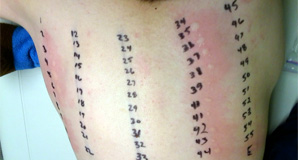Allergy Skin Prick Tests
Who needs an Allergy Test?
Allergy has been implicated in varying degrees in the following disorders
Atopic dermatitis (eczema)
Anaphylaxis/food allergy
Asthma.
Allergic rhinitis
Eosinophilic oesophagtitis
Allergic rhinoconjuctivitis (hay fever)
Urticaria (hives)
Irritable bowel syndrome
Occupational dermatitis
What is an Allergy?
Allergies are abnormal immune responses to commonly occurring substances (that are not harmful in themselves).
Most clinicians understand allergy to relate symptoms due to a type 1 hypersensitivity reaction whereby allergy antibody (IgE) bound to mast cells encounters a specific allergen which results in degranulation of the mast cell and release of histamine and other mediators of allergic inflammation.
The stimulus for such reactions include foods, inhalants (pollens, dusts, animal dander), insect bites and drugs.
The diagram to the left is an illustrative example of the cascade of events that occur following the initial exposure to ragweed.
How are allergy tests done?
Skin tests and RAST blood test have been proven to be of benefit in the diagnosis of allergy. Skin prick tests have been proven to be more sensitive than a blood test (RAST test) and have the additional advantage of providing results almost immediately.
Unproven or unscientific allergy tests include kinesiology, leukocytotoxic test, electrodermal (Vega), hair analysis, iridology and pulse test. If you are on a regular antihistamine they should be discontinued prior to the test.
For long-acting antihistamines (Zirtek, Neoclarityn, Clarityn): These should not be taken for at least 72 hours prior to the test. For short-acting agents (Piriton, Vallergan, Dozol): the period is 24 hours. In cases of dermatitis, it is important that there is an adequate area of normal skin for testing.
Hospital admission is not required. The tests are done in a medically controlled environment by an accredited technician. You will be asked to complete an allergy questionnaire, which will enable us to target the types of allergen that may be responsible for your symptoms. The technician will apply the candidate allergens to the skin on your forearm (the back is used in younger less co-operative patients), histamine and a saline control are included. A gentle scratch is applied by stylet or lancet over each allergen (see Figure below). Readings are taken after 15 minutes. Results must be interpreted in the context of the allergy history. A physician reported result will be sent to you or your referring doctor within 2 days.
Standard Allergens
Foods: milk, egg-white, soy, rice, wheat, rye, potato, sesame, oats, sesame, grape, pear, strawberry, raspberry, banana, kiwi, celery, paprika, latex, tomato, beef, chicken, pork, lamb, tuna, cod, herring, shrimp, mussels, peanut, hazelnut, brazil nut, almond, pistachio, pecan, cashew.
Inhalants: dust-mite, grass pollens, tree pollens, birch, cat, dog, rabbit, horse, guinea- pig, aspergillus fumigatus, alternaria, cladosporium, candida albicans.
Are there any side effects?
Intradermal skin tests are safe. Occasionally there can be a large local reaction, which may cause some temporary discomfort. This can be treated with topical antihistamine or occasionally a non-sedating oral antihistamine. Subcutaneous adrenalin is available at all times in case of a severe systemic reaction, which is recognised as being extremely rare.
Through careful pre-procedure screening, systemic reactions have been avoided and there has never been an occasion where the administration of adrenalin has been required.
Cost?
Cost of Allergy Test varies on the panel tested and costs between 130-190 euro.
This involves initial consultation with a clinical scientist, allergy test, physician report and where appropriate, advice on specific allergen avoidance will be provided .
This procedure can take about one hour.
At AllergyCounts, through careful patient preselection and vetting, administration of adrenalin has never been required.

